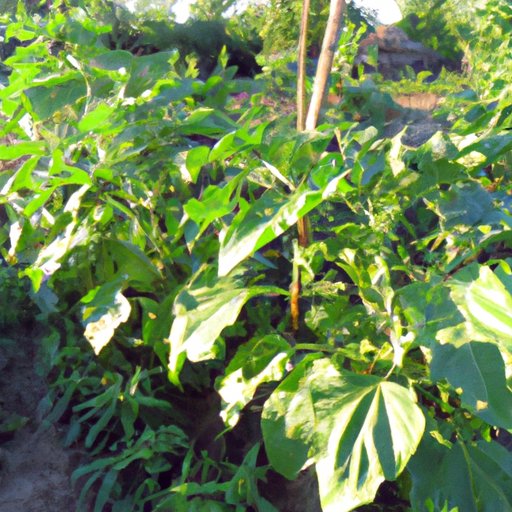Introduction
Growing vegetables can be an incredibly rewarding experience, but if you want to maximize your yields, it’s important to understand the principles of companion planting. Companion planting is the practice of grouping vegetables together in the same bed or row, with the goal of optimizing soil fertility, increasing yields, and reducing pest damage.
By understanding which vegetables grow best together, you can create a thriving garden that produces abundant harvests while minimizing the need for pesticides. In this article, we’ll explore the benefits of companion planting and discuss the best combinations of vegetables for maximum yields.
Exploring Companion Planting: What Vegetables Grow Best Together?
The first step in successful companion planting is to identify which vegetables are compatible. Each vegetable variety has different nutrient requirements and growth habits, so it’s important to choose the right combination of plants to ensure optimal growth. Here is a list of some common vegetables that grow well together:
- Tomatoes and basil
- Carrots and radishes
- Cucumbers and peas
- Beans and corn
- Lettuce and spinach
- Squash and beans
When choosing vegetables to plant together, it’s also important to consider their growth habits. For example, tomatoes are tall-growing plants that require plenty of sunshine, whereas lettuce and spinach prefer cooler temperatures and partial shade. By selecting vegetables with similar growth requirements, you can ensure that each plant receives the light and nutrients it needs to thrive.

Creating the Perfect Garden: Combining Vegetables for Maximum Yields
Once you’ve identified the vegetables you want to grow, it’s time to start planning your garden. Before you begin planting, it’s important to consider the nutrient needs of each vegetable variety. Some vegetables, such as tomatoes and peppers, require more nitrogen than others, while carrots and radishes need plenty of phosphorus and potassium.
By understanding the specific nutrient requirements of each vegetable, you can ensure that your soil contains all the necessary elements for optimal growth. Additionally, adding compost or manure to the soil will help provide additional nutrients to the plants. According to research published in the journal Agronomy, “Adding compost to the soil improved the physical, chemical, and biological properties of the soil, and increased the yield of vegetables.”
Another factor to consider when planning a garden is crop rotation. Crop rotation is the practice of rotating crops from one season to the next, with the goal of improving soil fertility and reducing disease and pest damage. By rotating crops, you can ensure that each plant receives the nutrients it needs for optimal growth.

Intercropping: Maximizing Space with Multiple Vegetable Varieties
If you’re limited on space, intercropping is a great way to maximize your garden’s potential. Intercropping involves planting multiple types of vegetables in the same bed or row, with the goal of increasing yields and reducing pest damage. For example, planting carrots and radishes together can help reduce the damage caused by aphids, while planting beans and squash together can help deter pests such as cucumber beetles.
When intercropping, it’s important to select vegetables with similar growth habits and nutrient requirements. Additionally, it’s important to remember that some plants, such as tomatoes and peppers, require more space than others, so it’s important to plan accordingly. As noted in a study published in the journal Frontiers in Plant Science, “Intercropping is an effective method for maximizing space utilization and increasing yields, provided the spacing and other agronomic factors are carefully considered.”
The Art of Planting Vegetables in Harmony
Organic gardening is the practice of growing vegetables without the use of synthetic fertilizers or pesticides. When done correctly, organic gardening can produce abundant harvests while maintaining a healthy ecosystem. To achieve success with organic gardening, it’s important to select the right fertilizers and soil amendments for your plants. Compost, manure, and seaweed extracts are all excellent sources of nutrients for your garden.
Additionally, it’s important to select the right mulch for your garden. Mulches, such as straw and hay, can help retain moisture in the soil and suppress weeds. As noted in a study published in the journal HortScience, “Mulching has been shown to improve soil structure, increase water retention, and reduce weed competition, resulting in improved yields.”
Pesticide-Free Gardening: Growing Vegetables Together to Reduce Pest Damage
One of the main benefits of growing vegetables together is that it can help reduce pest damage. By planting compatible vegetables together in the same bed or row, you can create a natural barrier against pests. Additionally, certain plants, such as marigolds, can act as natural repellents against harmful insects.
Other techniques, such as hand-picking pests and encouraging beneficial insects, can also help reduce pest damage. As noted in a study published in the journal Agriculture, “The use of natural predators and parasites, as well as cultural practices such as crop rotation and intercropping, can help reduce pest damage and increase yields.”
Conclusion
Growing vegetables together can be an incredibly rewarding experience, and it’s a great way to maximize yields while minimizing the need for pesticides. By understanding the principles of companion planting, intercropping, and natural pest control, you can create a thriving garden that produces abundant harvests. Additionally, by selecting the right fertilizers and soil amendments, you can ensure that your plants receive the nutrients they need for optimal growth.
In summary, companion planting is a great way to maximize yields and reduce pest damage. By understanding the principles of organic gardening and selecting the right combination of vegetables, you can create a healthy and productive garden that produces abundant harvests.
(Note: Is this article not meeting your expectations? Do you have knowledge or insights to share? Unlock new opportunities and expand your reach by joining our authors team. Click Registration to join us and share your expertise with our readers.)
